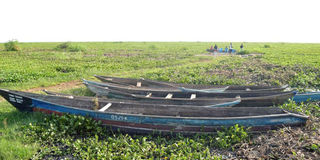War against hyacinth can’t be won without commitment

Boats marooned by water hyacinth on Uyoma Beach Lake Victoria in Kisumu.
Water hyacinth originated in Brazil, and probably entered Lake Victoria through the Kagera River in the 1980s. It spread rapidly between 1992 and 1998, reduced somewhat by 2001, and has re-emerged as a serious threat, covering more than 10,000 hectares of the lake in Kenya, Tanzania and Uganda.
Its spread has been fuelled by inflow of nutrient-rich water from urban, industrial and agricultural run-off, and insufficient waste water treatment.
Hyacinth has devastating impacts especially on the fishing industry, and as a result, efforts have been mounted to address it. One method is using mechanical harvesting machines – the government even brought a hyacinth collection machine to eradicate the weed – but this approach is time-consuming (covering no more than one to four acres a day) and expensive.
The biological method is recommended by scientists – using weevils and beetles to destroy the weed – and though slow, it is economical and effective in the long run. The third method using chemicals is least favoured because of its impact on the environment.
There is no single effective control technique – the mechanical method can easily deal with large infestations, while the biological method has proved effective in the long run – but what is clear is that though a lot of research has been done on Lake Victoria over the last two decades, continuing research is not drawing lessons from similar work done earlier.
LEARNING FROM PAST
It would be useful to know how previous attempts to fight water hyacinth fared, so that follow-up activities can build on previous successes and correct earlier mistakes.
To defeat water hyacinth, a number of measures must be put in place:
No one-size-fits-all method. No specific method can work equally well for all water bodies. In Lake Victoria, previous and current programmes tried both mechanical and biological methods with mixed results. Consequently, a combination of all techniques available should continue to be tried to see which one is most effective.
Heightened public awareness. Given that people are principally responsible for the spread of water hyacinth, public participation in control programmes is critical, in particular by the lake-shore communities where hyacinth has been a threat to livelihoods, public health and the regional economy. In addition, lake-shore communities should be involved in manual and biological control activities such as those using weevils.
POLITICAL COMMITMENT
Strong political will. There is need for strong political will from both national and county governments to fight hyacinth in Lake Victoria, a national asset particularly in the fishery sector. It is also worth noting that the major funding for fighting water hyacinth has always come from external sources. Even where progress has been made, once external funding ends, the weed re-appears. Because of largely external funding to combat water hyacinth, the problem has not aroused the needed national political commitment. Fighting hyacinth needs sustained funding and ongoing political commitment until it is eradicated.
Previous studies warned that water hyacinth remained established in the lake and new outbreaks were likely. Ideally, stringent control measures will be necessary to check further explosions of the weed, and it would seem wise to collect data in a more systematic manner on its causes, extent and effects. This is precisely the task that the Lake Victoria Environmental Management Project was supposed to perform. The way forward should be a combination of activities, including physical and biological control techniques, long-term nutrient reduction activities, consistent legislation, policies, and political commitment.
Dr Kakonge is the President of the Association of Former International Civil Servants (AFICS), Kenya chapter. He is former Ambassador to UN (Geneva)


